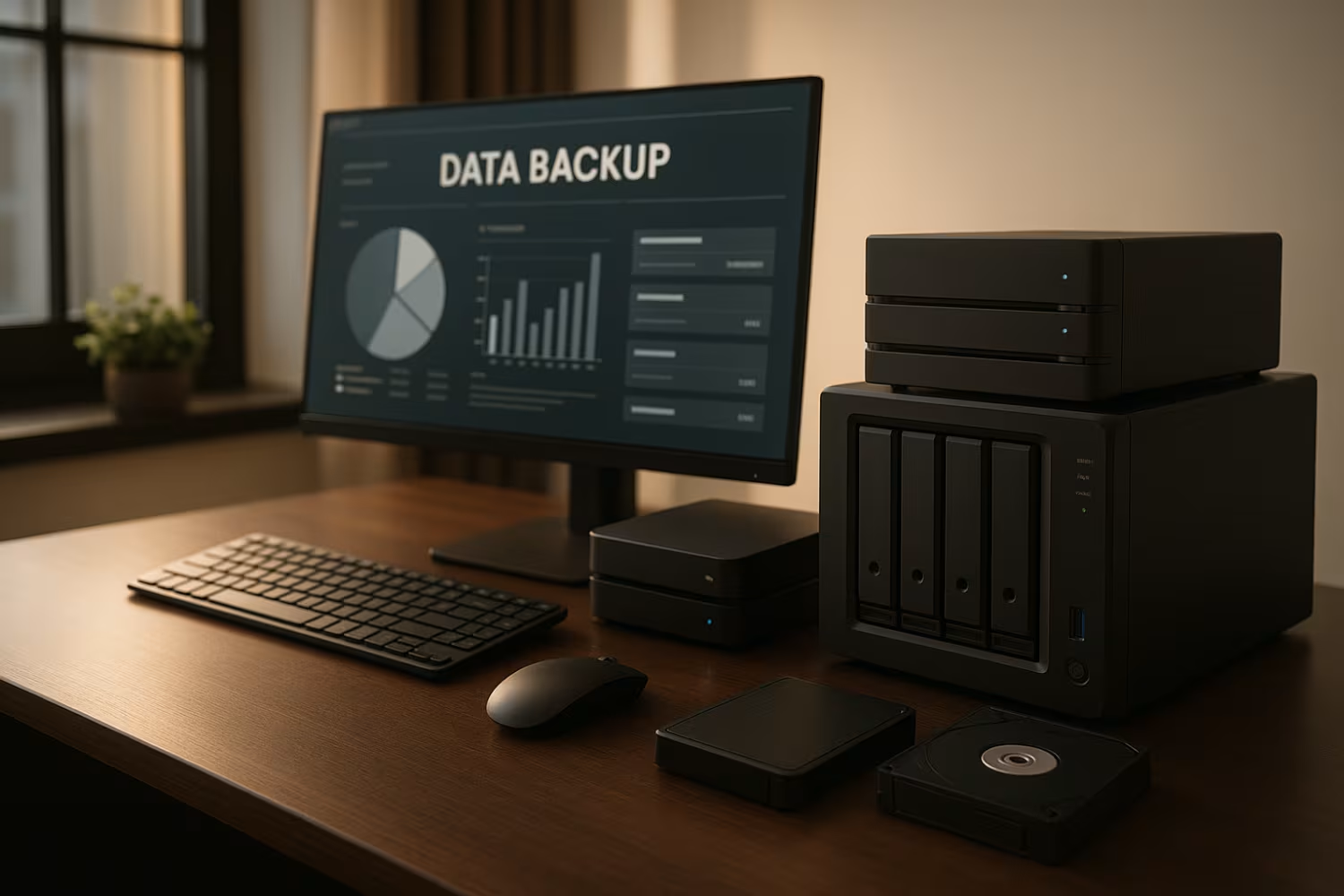Top Data Backup Strategies to Prevent Data Loss & Downtime
Data backup strategies are essential for protecting your business from data loss, downtime, and compliance issues. Whether you're storing files locally or using cloud storage, having a clear plan in place helps you recover quickly when something goes wrong. In this guide, you'll learn about common types of data backup, how to follow the 3-2-1 backup rule, and what best practices to use for long-term data protection.
We'll also cover how to choose the right backup solution, how often to back up data, and what to avoid when setting up your system. From full backups to incremental and differential methods, you'll get a practical overview of how to protect your critical data.
Understanding data backup strategies
A strong data backup strategy is more than just saving files. It’s a structured process that ensures your data is safe, accessible, and recoverable. Businesses need to think about what data to back up, how often to do it, and where to store it.
There are different types of data backup methods to consider. A full backup copies everything, while incremental and differential backups only copy changes. Each method has pros and cons, depending on how fast you need to restore data and how much storage space you have. Automated backup systems help reduce human error and ensure consistency.
The 3-2-1 backup strategy is a widely accepted best practice. It means keeping three copies of your data: two on different types of media and one offsite. This helps protect your data from hardware failure, cyberattacks, or natural disasters.

Common mistakes to avoid in your backup strategy
Even with good intentions, many businesses make errors that put their data at risk. Here are some common mistakes to watch out for:
Mistake #1: Relying on a single backup location
Storing all your backups in one place—like a local server—leaves you vulnerable to physical damage or theft. If that location fails, you lose everything. Always store at least one copy offsite.
Mistake #2: Infrequent backups
Backing up data once a week or month isn’t enough for most businesses. If you lose data, you could lose days or weeks of work. Set a backup frequency that matches how often your data changes.
Mistake #3: Not testing your backups
A backup is only useful if it works. Many companies don’t test their backup and recovery process until it’s too late. Schedule regular tests to make sure you can restore data when needed.
Mistake #4: Ignoring cloud backup options
Cloud backup offers flexibility and offsite protection. Ignoring it means missing out on scalable, secure storage. Use cloud services as part of your overall strategy.
Mistake #5: Forgetting about mobile and remote data
If your team uses laptops or mobile devices, that data needs protection too. Make sure your backup system includes remote endpoints.
Mistake #6: Using outdated backup software
Old or unsupported backup software may not handle modern threats or file types. Keep your tools updated to avoid compatibility and security issues.
Mistake #7: No disaster recovery plan
Backups are just one part of recovery. Without a disaster recovery plan, you may not know how to respond when data loss happens. Document your process and train your team.
Key benefits of a strong backup strategy
A reliable backup system offers several advantages:
- Reduces downtime by allowing fast data recovery
- Protects against ransomware and cyberattacks
- Helps meet compliance and regulatory requirements
- Supports business continuity during disasters
- Saves money by avoiding data recovery services
- Builds trust with clients and stakeholders

How the 3-2-1 backup strategy protects your business
The 3-2-1 backup strategy is a simple but powerful rule. It helps reduce risk by spreading your data across different formats and locations. Here’s how it works:
You keep three copies of your data: the original and two backups. Two of those copies should be stored on different types of media, like a hard drive and a network-attached storage (NAS) device. One copy must be stored offsite—either in the cloud or at a separate physical location.
Following this rule means that even if one copy is lost or damaged, you still have access to your data. It’s a best practice that works for businesses of all sizes.
Types of data backup methods explained
Different backup methods serve different needs. Here’s a breakdown of the most common types:
Method #1: Full backup
A full backup copies all your data. It’s the most complete option but takes the most time and storage. It’s often used as the base for other backups.
Method #2: Incremental backup
This method only backs up data that has changed since the last backup. It’s fast and uses less storage but can take longer to restore.
Method #3: Differential backup
Differential backups copy all changes made since the last full backup. It offers a balance between speed and storage use.
Method #4: Mirror backup
A mirror backup creates an exact copy of your data in real time. It’s useful for quick recovery but doesn’t protect against accidental deletions.
Method #5: Snapshot backup
Snapshots capture the state of your system at a specific point in time. They’re often used in virtual environments.
Method #6: Continuous data protection (CDP)
CDP backs up data in real time as changes occur. It’s ideal for businesses that can’t afford to lose even a few minutes of data.

Choosing the right backup solution for your business
When selecting a backup solution, consider your data volume, recovery time needs, and budget. Some businesses need fast recovery, while others prioritize long-term storage. Look for solutions that support automated backup and offer secure encryption.
Also, think about where your data is stored. Cloud storage is scalable and accessible, while on-premise storage gives you more control. Hybrid systems combine both for flexibility.
Best practices for managing your backup system
To get the most out of your backup strategy, follow these best practices:
- Set a clear backup schedule and stick to it
- Use automated backup tools to reduce human error
- Encrypt your backups to protect sensitive data
- Store backups in multiple locations
- Regularly test your restore process
- Keep documentation up to date
These steps help ensure your backup process is reliable and ready when you need it.

How Leet Services can help with data backup strategies
Are you a business with 15–80 employees looking for a reliable way to protect your data? As your company grows, so does the amount of data you need to manage. Without a solid backup plan, you risk losing files, slowing down operations, or even facing legal issues.
At Leet Services, we help businesses build and maintain secure, efficient data backup strategies. Our team works with you to design a system that fits your needs—whether that means using cloud backup, setting up automated processes, or following the 3-2-1 backup rule. Contact us today to get started.
Frequently asked questions
What is the best way to back up data for small businesses?
The best way to back up data is to use a mix of local and cloud backup systems. This ensures you have multiple copies of your files in different locations. A full backup done weekly, combined with daily incremental backups, offers a good balance of protection and efficiency.
Using backup software that supports automation helps reduce errors. Also, make sure to store at least one copy of your data offsite to protect against physical damage or theft.
How often should we back up our data?
Backup frequency depends on how often your data changes. For most small businesses, daily backups are a good starting point. If your data changes hourly, consider more frequent options like continuous data protection.
Automated backup systems make it easier to stick to a schedule. Always test your backups regularly to ensure you can restore data when needed.
What is the 3-2-1 backup rule and why does it matter?
The 3-2-1 backup rule means keeping three copies of your data: two on different types of media and one offsite. This reduces the risk of losing all your data at once.
Following this rule helps protect your data from hardware failure, cyberattacks, and natural disasters. It’s a simple but effective way to improve your data security.
What types of data should we prioritize in our backups?
Focus on backing up critical data first—like customer records, financial files, and operational documents. These are the files your business can’t function without.
Also consider backing up system configurations and application data. This makes it easier to restore your environment in case of a full system failure.
How do we choose between cloud and local backup options?
Cloud backup offers scalability and offsite protection, while local backup gives you faster access and more control. Many businesses use both in a hybrid approach.
When choosing, consider your internet speed, data volume, and recovery time needs. Cloud storage is ideal for offsite redundancy, while local storage works well for quick restores.
What should be included in a disaster recovery plan?
A disaster recovery plan should include your backup process, recovery steps, key contacts, and timelines. It should also outline how to access backup copies and restore data.
Make sure to test your plan regularly and update it as your systems change. This ensures your team knows what to do when disaster strikes.





.avif)
.avif)
.avif)


